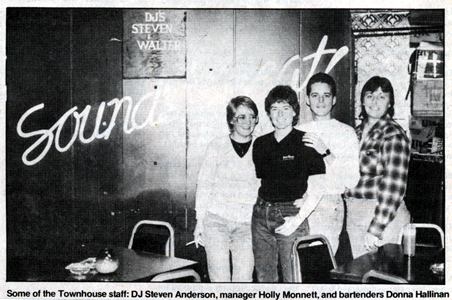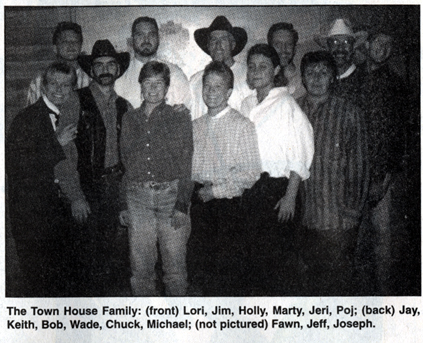Difference between revisions of "The Town House Bar"
m (table) |
m (Protected "The Town House Bar" [edit=sysop:move=sysop]) |
||
| (2 intermediate revisions by one other user not shown) | |||
| Line 4: | Line 4: | ||
| − | University Avenue is one of the busiest in Minnesota, as it connects two immense institutions—the University of Minnesota and [[Minnesota State Capitol]]. In the mid-20th century, University Ave. was St. Paul’s “white way | + | University Avenue is one of the busiest in Minnesota, as it connects two immense institutions—the University of Minnesota and [[Minnesota State Capitol]]. In the mid-20th century, University Ave. was St. Paul’s “white way,” a major commercial corridor for streetcar riders and, later, for automobile owners. The long strip suffered as auto dealerships left the inner-city beginning in the late 1970s, but it truly suffered when several major uses (notably [[Montgomery Wards]] and the Twin Cities Rapid Transit Company) went out of business. |
| − | |||
| − | |||
| − | |||
| Line 14: | Line 11: | ||
! | ! | ||
|- | |- | ||
| − | | | + | | This is especially evident in the Midway District (literally midway between Minneapolis and St. Paul), where the Town House began in 1969.<small>(1)</small> Emmet Jewel resolved the tax issues of an old art-deco bar between Snelling and Lexington Avenues. |
| − | + | The owners were unable to pay Jewel for his services, and instead gave the bar to him as payment.<small>(2)</small> Emmet understood the lucrative business that gay bars produced; he operated Town House without prejudice. | |
| <div style="text-align: center;"> | | <div style="text-align: center;"> | ||
[[Image:Svc_townhouse.jpg]] | [[Image:Svc_townhouse.jpg]] | ||
| Line 25: | Line 22: | ||
|} | |} | ||
| + | |||
| + | After many years, he eventually gave the Town House to his daughter Kelly, who happened to be a lesbian. | ||
| + | |||
| + | |||
| + | {| {{prettytable}} | ||
| + | ! | ||
| + | ! | ||
| + | |- | ||
| + | | In the 1990,<small>(3)</small> the Town House changed to a country-western bar and hosted line dancing lessons.<small>(4)</small> Those without penchants for cowboy hats were also welcome, the bar drew (and continues to draw) a diverse clientele. | ||
| + | |||
| + | |||
| + | It even draws Minneapolitans—the Town House arguably has maintained the best mix of men and women in the Twin Cities. This mix is particularly attractive to queer women in Minneapolis, where the bar scene is male-centric. | ||
| + | | <div style="text-align: center;"> | ||
| + | [[Image:Svc_twnhouse.jpg]] | ||
| + | </div> <div style="text-align: center;"> | ||
| + | <small>'''The Town House staff in 1997, from [[Lavender Magazine]] Issue 53. Courtesy of the [[Jean-Nickolaus Tretter Collection]].'''</small> | ||
| + | </div> | ||
| + | |} | ||
| + | |||
Presently under the ownership of longtime employee Holly Monnett, the easygoing bar dropped its western theme, but not its draw to queer women. Indeed, and without a proper “lesbian bar,” the Town House is one of the most popular sites for queer women in the Twin Cities metro area. | Presently under the ownership of longtime employee Holly Monnett, the easygoing bar dropped its western theme, but not its draw to queer women. Indeed, and without a proper “lesbian bar,” the Town House is one of the most popular sites for queer women in the Twin Cities metro area. | ||
| Line 30: | Line 46: | ||
---- | ---- | ||
| + | |||
| + | |||
<small>(1)</small>Douma, Greatchen. "Sixteen Years of Good Times." Equal Time, Issue 96 (12/18/1985). Page 8. | <small>(1)</small>Douma, Greatchen. "Sixteen Years of Good Times." Equal Time, Issue 96 (12/18/1985). Page 8. | ||
<small>(2)</small>Tretter, Jean-Nickolaus. Interview with the author, 2/22/10 | <small>(2)</small>Tretter, Jean-Nickolaus. Interview with the author, 2/22/10 | ||
| − | <small>(3)</small>Matthesen, Elise. “Les Bals Aux St. Paul” Gaze Magazine: issue 216, 5/13/1994. Page 35, 36. | + | <small>(3)</small> "Change and Community at the Town House" [[Lavender Magazine]], Issue 53: 6/6/1997. Page 57. |
| + | |||
| + | <small>(4)</small>Matthesen, Elise. “Les Bals Aux St. Paul” Gaze Magazine: issue 216, 5/13/1994. Page 35, 36. | ||
This page is still under construction. -SVC | This page is still under construction. -SVC | ||
Part of [[Minneapolis/St. Paul, MN: 100 Queer Places in Minnesota History, (1860-1969), (1969-2010)]] | Part of [[Minneapolis/St. Paul, MN: 100 Queer Places in Minnesota History, (1860-1969), (1969-2010)]] | ||
Latest revision as of 11:28, 1 May 2010
1415 University Avenue, St. Paul, MN
University Avenue is one of the busiest in Minnesota, as it connects two immense institutions—the University of Minnesota and Minnesota State Capitol. In the mid-20th century, University Ave. was St. Paul’s “white way,” a major commercial corridor for streetcar riders and, later, for automobile owners. The long strip suffered as auto dealerships left the inner-city beginning in the late 1970s, but it truly suffered when several major uses (notably Montgomery Wards and the Twin Cities Rapid Transit Company) went out of business.
| This is especially evident in the Midway District (literally midway between Minneapolis and St. Paul), where the Town House began in 1969.(1) Emmet Jewel resolved the tax issues of an old art-deco bar between Snelling and Lexington Avenues.
|
"Midway Landmark Celebrates Birthday!"Equal Time, Issue 96, page 8. Courtesy of the Jean-Nickolaus Tretter Collection. |
After many years, he eventually gave the Town House to his daughter Kelly, who happened to be a lesbian.
| In the 1990,(3) the Town House changed to a country-western bar and hosted line dancing lessons.(4) Those without penchants for cowboy hats were also welcome, the bar drew (and continues to draw) a diverse clientele.
|
The Town House staff in 1997, from Lavender Magazine Issue 53. Courtesy of the Jean-Nickolaus Tretter Collection. |
Presently under the ownership of longtime employee Holly Monnett, the easygoing bar dropped its western theme, but not its draw to queer women. Indeed, and without a proper “lesbian bar,” the Town House is one of the most popular sites for queer women in the Twin Cities metro area.
(1)Douma, Greatchen. "Sixteen Years of Good Times." Equal Time, Issue 96 (12/18/1985). Page 8.
(2)Tretter, Jean-Nickolaus. Interview with the author, 2/22/10
(3) "Change and Community at the Town House" Lavender Magazine, Issue 53: 6/6/1997. Page 57.
(4)Matthesen, Elise. “Les Bals Aux St. Paul” Gaze Magazine: issue 216, 5/13/1994. Page 35, 36.
This page is still under construction. -SVC
Part of Minneapolis/St. Paul, MN: 100 Queer Places in Minnesota History, (1860-1969), (1969-2010)

